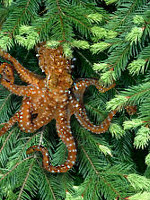Animal Lovers must act soon! This beautiful Cephalopod needs our help!
[quote]The Pacific Northwest Tree Octopus
i[/i]
[b]Help Save The Tree Octopus From Extinction![/b]
About The Pacific Northwest Tree Octopus

Tree octopus photo,
Rare photo of the elusive tree octopus
The Pacific Northwest tree octopus (Octopus paxarbolis) can be found in the temperate rainforests of the Olympic Peninsula on the west coast of North America. Their habitat lies on the Eastern side of the Olympic mountain range, adjacent to Hood Canal. These solitary cephalopods reach an average size (measured from arm-tip to mantle-tip,) of 30-33 cm. Unlike most other cephalopods, tree octopuses are amphibious, spending only their early life and the period of their mating season in their ancestral aquatic environment. Because of the moistness of the rainforests and specialized skin adaptations, they are able to keep from becoming desiccated for prolonged periods of time, but given the chance they would prefer resting in pooled water.
An intelligent and inquisitive being (it has the largest brain-to-body ratio for any mollusk), the tree octopus explores its arboreal world by both touch and sight. Adaptations its ancestors originally evolved in the three dimensional environment of the sea have been put to good use in the spatially complex maze of the coniferous Olympic rainforests. The challenges and richness of this environment (and the intimate way in which it interacts with it,) may account for the tree octopus’s advanced behavioral development. (Some evolutionary theorists suppose that “arboreal adaptation” is what laid the groundwork in primates for the evolution of the human mind.)
Reaching out with one of her eight arms, each covered in sensitive suckers, a tree octopus might grab a branch to pull herself along in a form of locomotion called tentaculation; or she might be preparing to strike at an insect or small vertebrate, such as a frog or rodent, or steal an egg from a bird’s nest; or she might even be examining some object that caught her fancy, instinctively desiring to manipulate it with her dexterous limbs (really deserving the title “sensory organs” more than mere “limbs”,) in order to better know it.
Range map
Map of estimated tree octopus maximum range, including spawning waters.
Tree octopuses have eyesight comparable to humans. Besides allowing them to see their prey and environment, it helps them in inter-octopus relations. Although they are not social animals like us, they display to one-another their emotions through their ability to change the color of their skin: red indicates anger, white fear, while they normally maintain a mottled brown tone to blend in with the background.
The reproductive cycle of the tree octopus is still linked to its roots in the waters of the Puget Sound from where it is thought to have originated. Every year, in Spring, tree octopuses leave their homes in the Olympic National Forest and migrate towards the shore and, eventually, their spawning grounds in Hood Canal. There, they congregate (the only real social time in their lives,) and find mates. After the male has deposited his sperm, he returns to the forests, leaving the female to find an aquatic lair in which to attach her strands of egg-clusters. The female will guard and care for her eggs until they hatch, refusing even to eat, and usually dying from her selflessness. The young will spend the first month or so floating through Hood Canal, Admiralty Inlet, and as far as North Puget Sound before eventually moving out of the water and beginning their adult lives.[color=green](read more the link)[/color]
zapatopi.net/treeoctopus/[/quote]
 I only wish I had the same kinda spare time as the author to even be able to think about the idea!
I only wish I had the same kinda spare time as the author to even be able to think about the idea! 



 you people think this is a joke?? it won’t be funny when theres not a single mountain walrus left on earth
you people think this is a joke?? it won’t be funny when theres not a single mountain walrus left on earth
